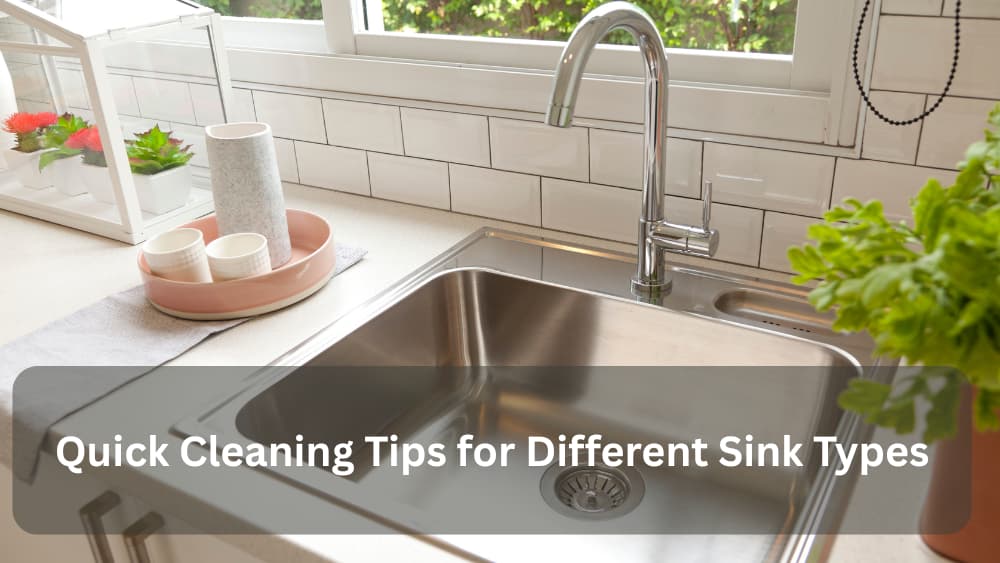Spills happen. Hard water stains show up. Food bits lurk around the drain. Your sink sees it all—multiple times a day. The good news? A fast, material-smart routine can keep any sink looking spotless without drama or damage. This guide gives you quick, no-nonsense tips for every common sink type so you can clean fast, clean right, and move on with your day.
Key Takeaways
- Match your method to the sink material. What’s safe for stainless can ruin stone or enamel.
- Work in this order: rinse → degrease → demineralize (if needed) → dry and buff.
- Use soft tools: microfiber cloths, soft sponges, nylon brushes. Skip steel wool.
- Keep a 30-second after-use routine: hot rinse, quick soap swipe, dry. It prevents 90% of buildup.
- When in doubt, check your manufacturer’s care sheet. It protects appearance—and warranties.
What’s the fastest universal routine that works for most sinks?
Three steps. Two minutes. No scratches.
- Hot rinse: Flush crumbs, soap scum, and coffee film.
- Mild soap wipe: A drop of dish soap on a damp microfiber; swish the bowl, rims, and faucet base.
- Dry and buff: Towel dry to stop water spots and leave a clean sheen.
Why it works: grease lifts, minerals don’t dry in place, and you avoid over-cleaning with harsh products. Do this after the last dish session of the day and your deep cleans get way easier.
How do you clean a stainless steel sink quickly without streaks?
Goal: Remove oils and spots while preserving the brushed grain.
Do this:
- Rinse hot, then wipe with dish soap + warm water using microfiber with the grain.
- For water spots, spritz 50/50 white vinegar + water, wait 1–2 minutes, wipe, then rinse and fully dry.
- Finish with a little isopropyl alcohol on a cloth for a streak-free sheen.
Avoid:
- Steel wool and gritty powders (permanent swirls).
- Bleach and chlorine-based gels (can pit stainless).
Pro move: A pea-size bead of stainless polish once a week helps repel fingerprints.
What’s the quick routine for porcelain/enamel sinks (including cast iron enamel)?
Goal: Clean gently to protect the glossy glass-like coating.
Do this:
- Daily: dish soap + warm water. Soft sponge only.
- For metal scuff marks, make a baking soda paste, dab, and wipe gently.
- For tea/coffee stains, lay a paper towel soaked in diluted hydrogen peroxide (3%) on the spot for 10–15 minutes, then rinse.
Avoid:
- Abrasive powders, pumice stones, or heavy scouring pads.
- Long contact with hair dye or nail-polish remover—stains and dulling happen fast.
Tip: A silicone sink mat cushions pots and prevents chips.
How do you speed-clean a granite composite sink?
(Also applies to other engineered stone/composite bowls.)
Do this:
- Soap + warm water for daily grime; soft brush for the corners.
- For chalky film or limescale, use diluted white vinegar (spritz, quick dwell, rinse). Don’t let acids sit.
- Dry after use to prevent white mineral outlines.
Avoid:
- Oven cleaner, drain-gel splashes, and undiluted bleach.
- Wire brushes—micro-scratches trap residue.
Revive: If the color looks dull, apply a composite sink care oil/conditioner per label, then buff dry.
What about natural stone sinks (marble, soapstone, limestone)?
One rule: No acids. Vinegar and lemon etch stone.
Do this:
- Clean with pH-neutral stone soap or a drop of dish soap, then rinse and dry.
- For dark oil rings, apply baking soda paste (with water), cover with plastic wrap for a few hours, then rinse.
Avoid:
- Vinegar, lemon, or abrasive powders.
- Sitting water—dry after use to reduce mineral halos.
Maintenance: Follow your installer’s guidance on sealing frequency. A fresh seal helps stains wipe off instead of soaking in.
How do you care for a fireclay sink quickly?
Fireclay has a vitrified, glossy surface similar to enamel.
Do this:
- Daily dish-soap wipe; rinse and dry.
- For metal marks from pans, spot with non-abrasive cream cleanser or baking soda paste.
Avoid:
- Scouring pads and strong acids.
- Slamming cast iron—chips occur at edges.
Prevent: A grid/rack in the base prevents impact chips and helps airflow so water spots don’t form.
What’s the right fast clean for copper sinks?
Copper patinas; don’t fight it unless you want the bright look.
Do this:
- Rinse, then wipe with dish soap and water. Dry thoroughly.
- For stuck food, use a nylon brush; for odor, a light baking soda paste—briefly—then rinse and dry.
Avoid:
- Bleach and acidic soaks; they strip patina and spot the surface.
- Abrasive powders.
Shine option: If you want bright copper, use a copper-safe polish occasionally, then wax lightly to slow re-tarnish.
How do you clean a quartz composite sink fast?
Quartz composites are hardy but dislike harsh chemicals.
Do this:
- Soap + warm water daily; nylon brush for texture.
- For water spots, a quick pass with diluted vinegar then rinse and dry.
Avoid:
- Concentrated bleach or solvent degreasers.
- Letting hot oil or dye sit—rinse promptly.
Refresh: A manufacturer-approved restorer/conditioner can even out tone if areas look chalky.
What’s the quick routine for acrylic sinks?
Acrylic scratches more easily than metal or stone.
Do this:
- Use mild soap, warm water, and a soft sponge.
- For film, use a plastic-safe, non-abrasive polish/cleanser.
Avoid:
- Acetone, strong solvents, and abrasive powders.
- Hot pans—use a rack to avoid heat warping.
Which faucet and drain ring tips help every sink look instantly cleaner?
- Faucets: Wipe base daily; for mineral crust, wrap a vinegar-soaked strip of paper towel around the base for 5 minutes, then rinse and dry. (Keep vinegar off natural stone.)
- Drains/strainers: Soak removable parts in warm soapy water weekly; scrub with a nylon brush; dry to prevent tarnish.
- Overflow slots (bath/utility): Blast with a turkey baster of hot water + a drop of soap; rinse.
What quick fixes remove hard-water spots without harming the finish?
- Stainless, composite, quartz composite: light vinegar spritz, short dwell, rinse, dry.
- Enamel/fireclay: use citric-based bathroom cleaner labeled non-abrasive; quick contact only.
- Natural stone: use stone-safe de-scaler (pH neutral) or lift by gentle scrubbing + frequent drying. Avoid vinegar.
Always dry after descaling. Minerals won’t reappear if nothing dries on the surface.
Which tools belong under every sink (and why)?
- Microfiber cloths (x3): wash/dry/buff stations.
- Soft sponge + nylon detail brush: corners, seams, strainer baskets.
- Plastic scraper: lifts dried food without scratching.
- Spray bottles (2): one for dish-soap solution; one for vinegar mix (mark “NO STONE”).
- Towel or small rack: instant dry = fewer spots.
What’s a 5-minute weekly reset that keeps sinks like new?
- Remove rack/strainer; soak in soapy water.
- Soap wipe of bowl, rims, faucet base; brush seams and drain.
- Quick mineral pass (vinegar where safe); rinse thoroughly.
- Dry and buff.
- Reassemble, then add one drop of stainless polish or sink conditioner if your material supports it.
This tiny ritual prevents stains, scale, and the “permanent haze” that takes ages to reverse.
What mistakes should you avoid no matter the sink?
- Abrasives on glossy finishes: scratches trap grime and dull shine.
- Letting acids sit: even safe acids can mar metal lines or etch grout/stone.
- Soaking bleach: many sink materials (and faucets) react badly to chlorine.
- Skipping the dry: most “stains” are actually mineral outlines from air-drying.
Quick comparison table: what to use—and avoid—by sink type
| Sink Type | Fast Daily Cleaner | Spot/Scale Helper | Avoid |
|---|---|---|---|
| Stainless steel | Dish soap + warm water | Light vinegar, alcohol buff | Steel wool, bleach gels, gritty powders |
| Porcelain/enamel | Dish soap + soft sponge | Baking soda paste; brief peroxide on tea stains | Abrasives, pumice, long acid contact |
| Granite composite | Dish soap + nylon brush | Brief vinegar spritz; composite conditioner | Strong solvents, wire brushes |
| Natural stone (marble/soapstone) | pH-neutral stone soap | Stone-safe de-scaler; baking soda poultice for oils | Vinegar/lemon, abrasive powders |
| Fireclay | Dish soap, soft sponge | Non-abrasive cream cleaner for scuffs | Harsh scouring pads, strong acids |
| Copper | Dish soap + microfiber | Baking soda paste (brief); copper polish if desired | Bleach, harsh acids, abrasives |
| Quartz composite | Dish soap + nylon brush | Brief vinegar; manufacturer restorer | Concentrated bleach/solvents |
| Acrylic | Mild soap + soft sponge | Plastic-safe non-abrasive polish | Acetone/solvents, high heat, abrasives |
FAQs
Can I use disinfecting wipes in any sink?
They’re generally fine on stainless, composites, and enamel, but read the label and rinse after use—especially around food prep. Avoid repeated use on natural stone unless the wipe is stone-safe.
Is baking soda always safe?
As a paste, yes for spot work on many sinks. Avoid dry, gritty scrubbing on glossy enamel, acrylic, and soft stones.
Do I need special soap for stone?
Yes. A pH-neutral stone soap protects sealers and reduces etching risk.
Why do spots come back right after cleaning?
Usually because the surface air-dried. Drying and buffing is the secret step most people skip.
One last 30-second habit that changes everything
At the end of the day, hot rinse → one-wipe with suds → dry. It’s simple, fast, and keeps every sink type looking new. Add the right spot-treaters for your material, and you’ll rarely need heavy scrubbing again.
By matching your cleaner to the sink, using soft tools, and drying every time, you protect finishes, prevent stains, and save time. Clean smarter, not harder—and enjoy a sink that actually looks as clean as it is.

As the chief content writer, Hassan Al Sarker works as a professional kitchen-based content creator at Kitchen Liker.
In addition to reviewing the content published on Kitchen Liker, he ensures that it is accurate, relevant, and helpful. As a result, all the reviews and information published at Kitchen Liker are neutral and userfriendly.
Hassan Al Sarker has a bachelor’s degree in Hotel and Tourism Management From the Newyork University. Before joining Kitchen Liker, he was a contributor at Kitchen Club, United States.

